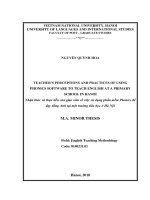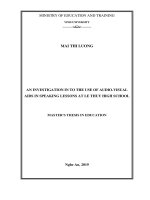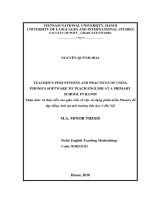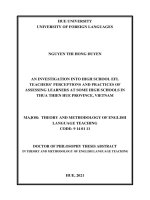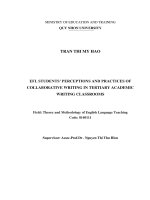Efl students perceptions and practices of using hot potatoes in reading lessons at nguyen du high school
Bạn đang xem bản rút gọn của tài liệu. Xem và tải ngay bản đầy đủ của tài liệu tại đây (1.31 MB, 98 trang )
MINISTRY OF EDUCATION AND TRAINING
QUY NHON UNIVERSITY
PHUNG THI XUAN TRANG
EFL STUDENTS’ PERCEPTIONS AND PRACTICES
OF USING HOT POTATOES IN READING LESSONS
AT NGUYEN DU HIGH SCHOOL
Major: Theory and Methodology of English Language Teaching
Code: 8140111
Supervisor: Assoc. Prof. Dr. Nguyen Quang Ngoan
Binh Dinh - 2023
BỘ GIÁO DỤC VÀ ĐÀO TẠO
TRƯỜNG ĐẠI HỌC QUY NHƠN
PHÙNG THỊ XUÂN TRANG
NHẬN THỨC VÀ THỰC HÀNH CỦA HỌC SINH
TRONG VIỆC SỬ DỤNG PHẦN MỀM
HOT POTATOES TRONG CÁC TIẾT ĐỌC
TẠI TRƯỜNG THPT NGUYỄN DU
Ngành: Lý luận và phương pháp dạy học bộ môn Tiếng Anh
Mã số: 8140111
Người hướng dẫn: PGS. TS. Nguyễn Quang Ngoạn
Bình ĐỊNH - 2023
i
DECLARATION OF AUTHORSHIP
I hereby declare that this thesis titled "EFL students’ perceptions and
practices of using Hot Potatoes in reading lessons at Nguyen Du High School"
and all the work presented within it are my original contributions, unless otherwise
stated. I confirm that this thesis has not been submitted in whole or in part for any
other academic award/degree, and it has not been previously published.
Wherever the work of others has been used, credited references have been
provided, and appropriate acknowledgments have been made. Any contributions of
others to this thesis have been duly recognized, and their works have been cited
accordingly.
ii
ACKNOWLEDGEMENTS
I would like to take this opportunity to express my heartfelt gratitude to all the
individuals and institutions who have supported me throughout the journey of
completing this thesis. Their unwavering encouragement, guidance, and assistance
have been instrumental in shaping the outcome of this work.
First and foremost, I am deeply grateful to my supervisor, A. Prof. Nguyen
Quang Ngoan, whose expertise, patience, and valuable feedback have been the
driving force behind the successful completion of this research. His mentorship has
not only refined my understanding of the subject but has also instilled in me the spirit
of resilience and dedication.
I extend my sincere appreciation to all the lecturers of Quy Nhon University,
whose passion for academia has left a lasting impact on my intellectual growth. Their
commitment to excellence and willingness to share their knowledge have inspired me
throughout this academic journey.
I am also grateful to the participants of Nguyen Du High School in this study.
Their willingness to share their time and insights has been invaluable. Without their
cooperation, this research would not have been possible, and their contributions will
undoubtedly benefit future studies in this field.
I would like to express my gratitude to my friends for their unending support
and camaraderie. The late-night brainstorming sessions and the exchange of ideas
have been pivotal in shaping the direction of my research. Their friendship and belief
in my abilities have provided me with the motivation to overcome challenges and
persevere.
I am indebted to my family for their unconditional love and unwavering
support. Their belief in my potential has been a constant source of strength. Their
understanding, patience, and encouragement have helped me maintain a balance
between my personal and academic life.
iii
TABLE OF CONTENTS
DECLARATION OF AUTHORSHIP .................................................................... i
ACKNOWLEDGEMENTS .................................................................................... ii
ABSTRACT............................................................................................................. vi
LIST OF ABBREVIATIONS ............................................................................... vii
LIST OF TABLES ................................................................................................ viii
LIST OF FIGURES ................................................................................................ ix
CHAPTER I. INTRODUCTION ............................................................................1
1.1. Rationale.......................................................................................................1
1.1.1. Theoretical Reasons ............................................................................. 1
1.1.2. Contextual Reasons.............................................................................. 3
1.2. Research Aim and Objectives.....................................................................4
1.2.1. Aim........................................................................................................ 4
1.2.2. Objectives .............................................................................................. 4
1.3. Research Questions......................................................................................4
1.4. Scope of the Study........................................................................................5
1.5. Significance of the Study.............................................................................5
1.6. Structure of the Study .................................................................................6
CHAPTER 2. LITERATURE REVIEW................................................................7
2.1. Reading Learning and Teaching ......................................................................7
2.1.1. Reading.. ............................................................................................... 7
2.1.2. Teaching Reading .............................................................................. 10
2.1.3. Learning Reading............................................................................... 15
2.2. Computer-Assisted Language Learning (CALL)...................................17
2.3. Hot Potatoes ...............................................................................................21
2.3.1. Programs and Functions of Hot Potatoes......................................... 23
2.3.2. Features in Hot Potatoes ................................................................... 32
2.3.3. Strengths and Weaknesses of Hot Potatoes ...................................... 33
2.4. Previous Studies.........................................................................................35
iv
CHAPTER 3. METHODOLOGY .........................................................................39
3.1. Research Methods......................................................................................39
3.2. Research Setting ........................................................................................41
3.3. Research Participants ...............................................................................41
3.4. Research Instruments ...............................................................................42
3.4.1. Questionnaire ..................................................................................... 42
3.4.2. Semi-structured interview .................................................................. 43
3.4.3. Observation......................................................................................... 44
3.5. Data Collection and Analysis Procedures ...............................................45
3.6. Reliability and Validity .............................................................................47
3.7. Ethical Considerations ..............................................................................48
CHAPTER 4. RESULTS AND DISCUSSION ....................................................50
4.1. Participants’ Demographics .....................................................................50
4.2. Students’ Perceptions of Hot Potatoes.....................................................51
4.2.1. Results from the Questionnaire ......................................................... 51
4.2.2. Results from the Interview ................................................................. 54
4.3. Students’ Practices of Hot Potatoes .........................................................57
4.3.1. Results from the Questionnaire ......................................................... 57
4.3.2. Results from the Interview ................................................................. 59
4.3.3. Results from the Observation ............................................................ 62
4.4. Chapter Summary .....................................................................................66
CHAPTER 5. CONCLUSION ...............................................................................67
5.1. Summary of Key Findings ........................................................................67
5.2. Concluding Remarks.................................................................................68
5.3. Implications ................................................................................................69
5.3.1. Theoretical Implications .................................................................... 69
5.3.2. Practical Implications ........................................................................ 70
5.4. Limitations .................................................................................................72
5.5. Suggestions for Further Studies ...............................................................72
v
REFERENCES ........................................................................................................74
APPENDICES
vi
ABSTRACT
The current study aims to explore EFL students’ practices and perceptions of
using Hot Potatoes in learning reading skills. In order to obtain the research aims and
objectives, the researcher adopted the mixed-methods research design. Three research
instruments used by the researcher to collect data included the questionnaire,
interview, and observation. 80 Grade 12 students from Nguyen Du High School.
Quantitative data collected from the questionnaire and qualitative data gathered from
the interview and observation were used to answer the two research questions
concerning the students’ practices of Hot Potatoes and their perceptions. Data
analysis revealed: (1) Students used all six programs of the Hot Potatoes application,
including JCloze, Jmatch, Jquiz, Jcross, Jmix, and The Masher to gain more
vocabulary for reading comprehension; (2) Students can approach different types of
exercise when using the Hot Potatoes application; (3) Students’ learning engagement,
autonomy and motivation were improved owing to the use of Hot Potatoes; (4)
Students used the Hot Potatoes application to gain interactive feedbacks for their
performance and progress; and (5) Students expressed their positive perception of
Hot Potatoes because of its benefits. Based on the research findings, the researcher
generated the implications for the effective use of Hot Potatoes in learning and
teaching reading skills.
Keywords: EFL students, Hot Potatoes, perceptions, practices, reading skills
vii
LIST OF ABBREVIATIONS
1) CALL: Computer Assisted Language Learning
2) EFL: English as a Foreign Language
3) ICT: Information and Communications Technologies (ICT)
4) L2: Foreign Language
5) TAM: Technology Acceptance Model
viii
LIST OF TABLES
Table 2.1. Micro skills of Reading Comprehension ..........................................14
Table 2.2. Types of exercises in Hot Potatoes ...................................................32
Table 4.1. Participants’ demographics .............................................................. 50
Table 4.2. Students’ perceptions of Hot Potatoes ..............................................51
Table 4.3. Students’ practices of Hot Potatoes ..................................................58
Table 4.4. Observation results ........................................................................... 63
ix
LIST OF FIGURES
Figure 2.1. A Model of Reading Comprehension ...............................................9
Figure 2.2. Hot Potatoes ....................................................................................22
Figure 2.3. Jcloze ............................................................................................... 25
Figure 2.4. JMatch .............................................................................................26
Figure 2.5. JQuiz ...............................................................................................28
Figure 2.6. Jmix .................................................................................................30
Figure 2.7. The Masher ......................................................................................31
Figure 3.1. Data collection and analysis procedures ......................................... 47
1
CHAPTER I. INTRODUCTION
1.1. Rationale
1.1.1. Theoretical Reasons
English as a compulsory subject taught at all education levels in many
countries worldwide, including Vietnam. In Vietnam, the pursuit of English
proficiency has become a national priority, reflecting the global significance of the
language. English is considered a gateway to international opportunities, and the
Vietnamese education system has adapted to meet the demands of a rapidly
globalizing world (Harahap, 2012; Cakici, 2020).. English learning begins early in
Vietnamese schools, with a structured curriculum that aims to develop students'
listening, speaking, reading, and writing skills.
Concerning English learning in the high school context, high schools in
Vietnam play a pivotal role in shaping students' English proficiency, as they prepare
for higher education and future careers. English is a mandatory subject in high school,
and the curriculum focuses on building advanced language skills. The emphasis is
not only on linguistic competence but also on fostering critical thinking and
communication abilities in English (Huckin et al., 2013). High school English
teachers strive to create an immersive learning environment, incorporating diverse
teaching strategies to engage students. Despite constraints, efforts are being made to
introduce modern teaching tools and technology to enhance the quality of English
education. The ultimate goal is to equip Vietnamese high school students with the
language skills and cultural awareness needed to navigate a globalized society and
contribute to Vietnam's development on the international stage.
When acquiring any foreign language, learning reading comprehension is a
cornerstone, playing a pivotal role in fostering a comprehensive and nuanced
understanding of a language. Therefore, teaching reading comprehension is the key of
any curriculum. The landscape of teaching reading comprehension has undergone a
profound transformation, moving away from traditional methodologies towards
communicative contemporary (Pan & Wu, 2013; Pan & Huang, 2019). In the traditional
2
paradigm, reading comprehension often involved rote memorization, decoding of
isolated vocabulary, and passive absorption of information (Jin & Cortazzi, 2014; Pan &
Wu, 2013). However, recognizing the evolving needs of learners and the demands of the
modern world, educational practices have shifted towards more student-centered and
interactive strategies (Gomleksiz, 2017; Ning, 2017).
Accordingly, communicative methods have emerged as powerful tools for
teaching reading comprehension, transforming the traditional approach into an
interactive and dynamic learning experience (Brown, 2017). Unlike conventional
methods that often focus on decoding and memorization, communicative methods
prioritize the use of language for authentic communication and meaning-making
(Suh, 2019).
Central to these methods is the concept of interactive reading, where students
actively engage with the text through discussions, collaborative activities, and real-life
applications. This approach recognizes that language is a living, communicative tool
rather than a static set of rules. According to Tsai (2019), by fostering an environment
where students can express their thoughts, opinions, and interpretations, communicative
methods promote a deeper understanding of the material.
Technology integration is a key aspect of communicative methods.
Technology plays a significant role in contemporary reading instruction (Pan & Wu,
2013; Gomleksiz, 2017). Digital tools, multimedia resources, and interactive
platforms enable educators to create immersive reading experiences. These methods
not only cater to diverse learning styles but also foster a love for reading by making
it a dynamic and participatory process. Additionally, collaborative learning,
discussions, and real-world applications are integrated into contemporary
approaches, fostering a deeper understanding of the text and enhancing critical
literacy skills (Ning, 2017).
As stated, in the evolving landscape of language education, technology has
become an invaluable ally, enriching traditional teaching methods and providing
innovative avenues for interactive learning. One such tool that has garnered attention
3
in language classrooms is Hot Potatoes, Produced by Half-Baked Software, Inc., —a
versatile suite of quiz authoring tools designed to create interactive and engaging
exercises. Beyond its application in various language skills, Hot Potatoes has proven
particularly effective in the realm of teaching reading, offering educators dynamic
ways to enhance comprehension and critical thinking (Ghorbanpour, 2018).
Hot Potatoes provides educators with the capability to design customized
reading exercises that go beyond static texts, incorporating interactive elements such
as multiple-choice questions, gap-filling activities, and matching exercises (Vargas
& Monge, 2014). This interactive format not only captures students' attention but also
actively involves them in the learning process. Reading lessons, traditionally
confined to passive absorption of information, are transformed into dynamic
experiences where students can interact with the text, respond to questions, and
receive immediate feedback (Sadeghi, 2015). Owing to the benefits of Hot Potatoes,
the researchers performed the studies exploring the use of hot potatoes in English
language teaching and learning. For instance, Putri's (2014) research delved into the
application of Hot Potatoes in reading instruction. The findings demonstrated that
integrating the Hot Potatoes program not only facilitated students' learning processes
but also heightened their motivation to learn. In a study by Zinaga (2014), students'
perceptions regarding the utilization of Hot Potatoes were examined. The data
analysis revealed universally positive feedback from all participants, indicating a
favorable reception of Hot Potatoes in the learning environment. Similarly,
Ghorbanpour's (2018) investigation explored the implementation of Hot Potatoes to
enhance paragraph writing skills. The outcomes indicated that integrating Hot
Potatoes into paragraph writing activities offered students valuable opportunities to
grasp and reinforce the nuances of rhetorical structure. To sum up, previous studies
indicated the positive impacts of using hot potatoes on different aspects of language
learning, including reading (Erben et al., 2019) and students’ positive perceptions
towards hot potatoes.
1.1.2. Contextual Reasons
4
When it comes to teaching reading at Nguyen Du High School, English
teachers have been experimenting with various instructional methods to enhance
students' reading abilities. The objective is to enable students to comprehend and
analyze written texts with ease and effectiveness. The broader aim includes advancing
the students' core skills—listening, speaking, reading, and writing. The teachers aim
to introduce texts that encompass novel ideas, facilitating students in utilizing and
building upon their existing knowledge to comprehend texts and acquire more
information on the subjects. Additionally, efforts are directed towards assisting
students in expanding their vocabulary within context, learning new words, and
introducing them to new grammatical structures and challenges, thereby aiding
students in understanding and mastering these linguistic elements. Among different
techniques, Hot Potatoes has been employed as a tool to support students’ reading
learning. The preliminary study indicates the positive impacts of using Hot Potatoes
on students’ reading performance illustrated by their increase in test scores. However,
how the students at Nguyen Du high school use Hot Potatoes and their perceptions
towards Hot Potatoes have not been investigated. Therefore, the current study
attempts to explore EFL students’ perceptions and practices of using Hot Potatoes in
reading lessons at Nguyen Du High School.
1.2. Research Aim and Objectives
1.2.1. Aim
The study aims to examine EFL students’ use and their perceptions of Hot
Potatoes in learning reading skills.
1.2.2. Objectives
Specifically, the following objectives are generated:
1) To explore how EFL students use Hot Potatoes to learn reading skills.
2) To investigate EFL students’ perceptions of the use of Hot Potatoes in
learning reading skills.
1.3. Research Questions
5
In order to obtain research aim and objectives, the following research
questions are derived:
1) How do EFL students use Hot Potatoes to learn reading skills?
2) What are EFL students’ perceptions towards the use of Hot Potatoes in
learning reading skills?
1.4. Scope of the Study
Because the time is limited, the study mainly focused on investigating EFL
students’ practices and perceptions concerning how the use of Hot Potatoes promotes
their reading skills. The study was performed at Nguyen Du High School with the
participation of 80 EFL Grade 12 students. All these students had experienced the use
of Hot Potatoes in learning reading lessons so that they coud reveal the findings
concerning the practices and perceptions of Hot Potatoes.
1.5. Significance of the Study
Theoretically, the researcher chose this study with the hope that the findings
of the study will contribute to the field of using Information and Communications
Technologies (ICT) in language learning. This study recommends Hot Potatoes in
particular as an appealing and user-friendly authoring tool that teachers may use to
create activities and as a learning medium to assist students in increasing their reading
comprehension. Since Hot Potatoes contains a variety of exercises, students can
strengthen their reading comprehension by responding to the questions. Through
those various exercises, teachers can motivate students to learn reading
comprehension.
Practically, this study is significant because of the following reasons. First and
foremost, there have not been any studies on the use of Hot Potatoes in learning
reading skills at Nguyen Du High School; this study, therefore, will be conducted in
the hope of enriching the source of data for future research at Nguyen Du High
School. In addition, that the study will shed light on how Hot Potatoes has been used
by students in learning English reading lessons and their perceptions towards Hot
6
Potatoes; those findings hopefully make significant contribution to the field of
English reading teaching and learning in general and help English teachers at Nguyen
Du High School to recognize the current situation and improve their use of ICT tools
in learning and teaching English. More worthily, it is expected that the students’
positive perceptions towards Hot Potatoes examined by the use of technology
acceptance model (TAM) will generate the useful framework to understand how Hot
Potatoes is used by EFL students and their perceptions of Hot Potatoes as a helpful
ICT educational tool.
1.6. Structure of the Study
The thesis is organized into five chapters as follows:
Chapter 1, Introduction, presents the rationale, aims, and objectives, research
questions, the scope of the study, the significance of the study, and the organization
of the study.
Chapter 2, Literature Review, provides the theoretical background on which the
study is based and briefly present a review of previous studies related to this study.
Chapter 3, Research Methods and Procedures, deals with the research
methods, research procedures, data collection, data analysis.
Chapter 4, Findings and Discussions, focuses on exploring how EFL students
have used Hot Potatoes to learn reading skills and investigating EFL students’
perceptions towards the use of Hot Potatoes in learning reading skills
Chapter 5, Conclusion, gives a summary of the results of the study. It also
offers limitations of the study and suggestions for further research.
7
CHAPTER 2. LITERATURE REVIEW
In this chapter, the researcher reviews the existing literature concerning the
use of Hot Potatoes in teaching reading. Specifically, theoretical foundation of
reading, learning and teaching reading is established at the beginning of the chapter.
Then, Computer Assisted Language Learning (CALL) is discussed with reference to
its origin, development and application in foreign language (L2) learning. Other areas
of focus in this chapter involve Hot Potatoes, its features, strengths and weaknesses
of Hot Potatoes, and the use of Hot Potatoes in teaching reading. Finally, related
studies are examined to find out empirical findings of how Hot Potatoes is used to
promote EFL students’ reading skills and to identify the literature gaps that are
addressed in the current study.
2.1. Reading Learning and Teaching
2.1.1. Reading
There are three steps in a reading lesson. The first one is pre – reading strategy,
where readers preview the material before delving into it. This involves scanning
headings, subtitles, and visual aids to activate prior knowledge and establish a mental
framework for understanding the content (Richards & Renandya, 2012).
During the reading process, active engagement is key. Annotation,
highlighting, and note-taking help in focusing attention on essential points, promoting
a deeper understanding of the material. Additionally, readers can employ the
questioning strategy, constantly asking themselves queries about the text to foster
critical thinking and engagement with the material (Brown, 2001).
Furthermore, according to Richards and Renandya (2012), post-reading
strategies play a vital role in consolidating comprehension. Summarization is an
effective technique where readers articulate the main ideas and key details in their
own words. This not only reinforces understanding but also aids in retention.
Discussion and reflection are other valuable post-reading strategies, allowing readers
to share insights, clarify doubts, and connect the material to personal experiences or
8
prior knowledge. Metacognition, or thinking about one's thinking, is an overarching
strategy that spans all stages of reading. It involves being aware of comprehension
processes, monitoring understanding, and adjusting strategies accordingly (Brown,
2001). Developing metacognitive skills empowers readers to take control of their
comprehension, making reading a more purposeful and strategic endeavor.
In sum, a combination of pre-reading, during-reading, and post-reading
strategies, coupled with metacognitive awareness, forms a holistic approach to
reading comprehension. Tailoring these strategies to individual preferences and the
nature of the material can significantly enhance one's ability to comprehend and
derive meaning from diverse texts.
Moreover, when mentioning reading comprehension it is crucial to explore the
factors influencing the learners’ reading comprehension achievement, regardless of
internal or external. Reading comprehension is a nuanced process influenced by a
myriad of internal and external factors (Kahayanto, 2014). Internally, individual
perceptions play a pivotal role in shaping how readers approach and interpret text.
Beliefs about one's own reading abilities, attitudes toward the subject matter, and
confidence in comprehension skills all contribute to the cognitive landscape of
reading. Motivation, another internal factor, acts as a driving force, impacting the
level of effort and attention a reader invests in understanding the material. Effective
problem-solving strategies, cultivated through experience and education, also shape
internal factors, guiding readers in navigating and comprehending complex texts
(Dorn & Soffos, 2005).
Sadeghi (2013) also states that external factors, on the other hand, encompass
elements outside the reader's cognitive domain. Text modality, including the use of
visuals, graphs, or multimedia, can significantly impact comprehension. Visual aids
can enhance understanding, while a dense or convoluted layout may pose challenges.
The characteristics of the text itself, such as vocabulary complexity and sentence
structure, contribute to external factors influencing comprehension. Time and place
are additional variables, as reading in a quiet, focused environment may yield
9
different results than reading in a distracting or time-pressured setting.
Figure 2.1
A model of Reading Comprehension
Source: Davies (2012)
Recognizing the interplay between internal and external factors is crucial in
understanding the complexities of reading comprehension. An individual's beliefs,
motivation, and problem-solving strategies interact dynamically with the inherent
characteristics of the text, its presentation, and the context in which it is encountered.
By acknowledging and addressing these multifaceted influences, educators and
readers alike can develop strategies to optimize comprehension outcomes and foster
a more effective reading experience (Dorn & Soffos, 2005; Sadeghi, 2013).
Alderson (2010) recommends specific assessment methods for evaluating
reading comprehension, including multiple-choice, cloze tests, matching exercises,
true-false evaluations, and ordering tasks. These assessment approaches are well-
suited for integration into web-based tasks using platforms like Hot Potatoes.
In sum, there are many definitions of reading stated by the scholars. While



